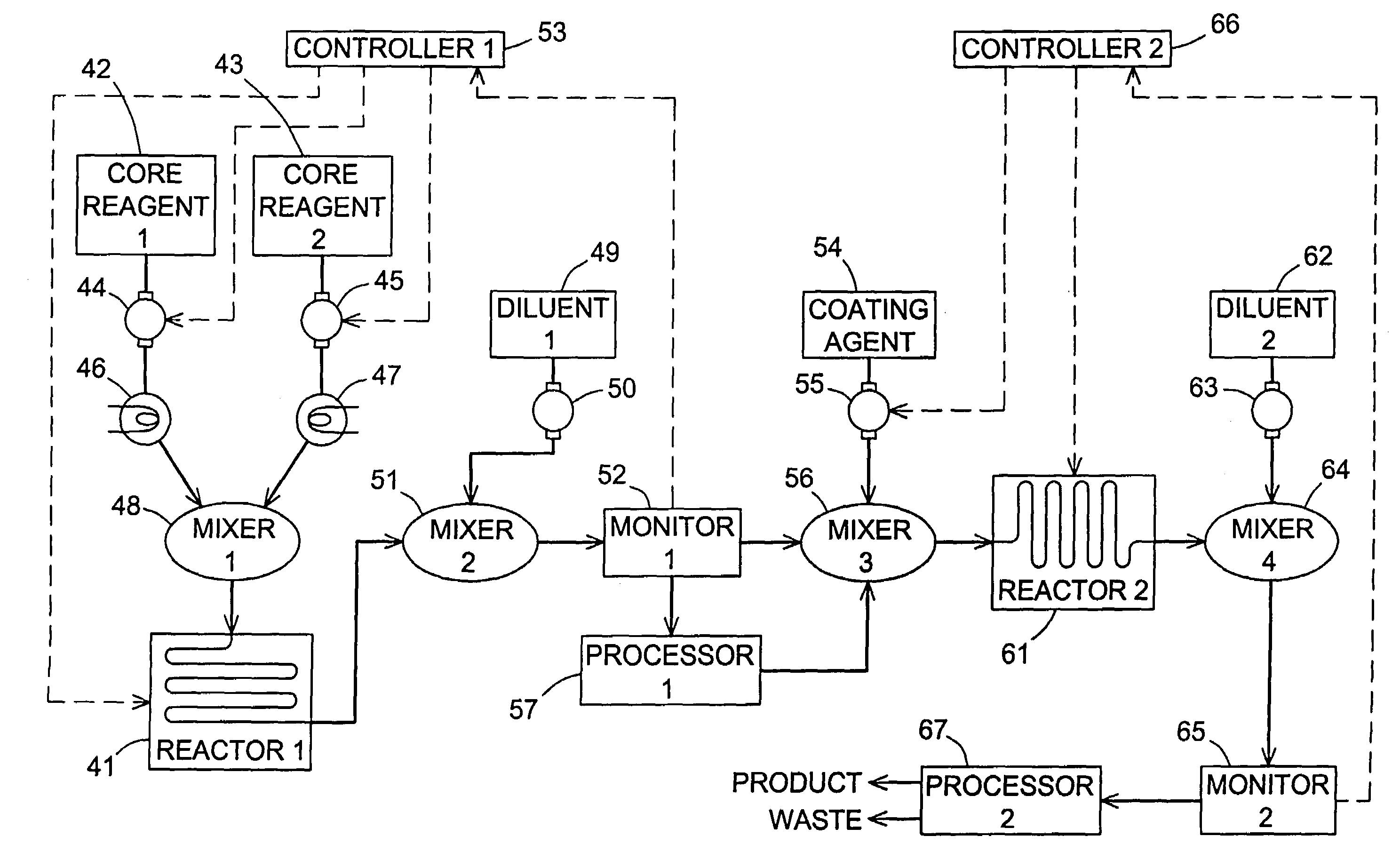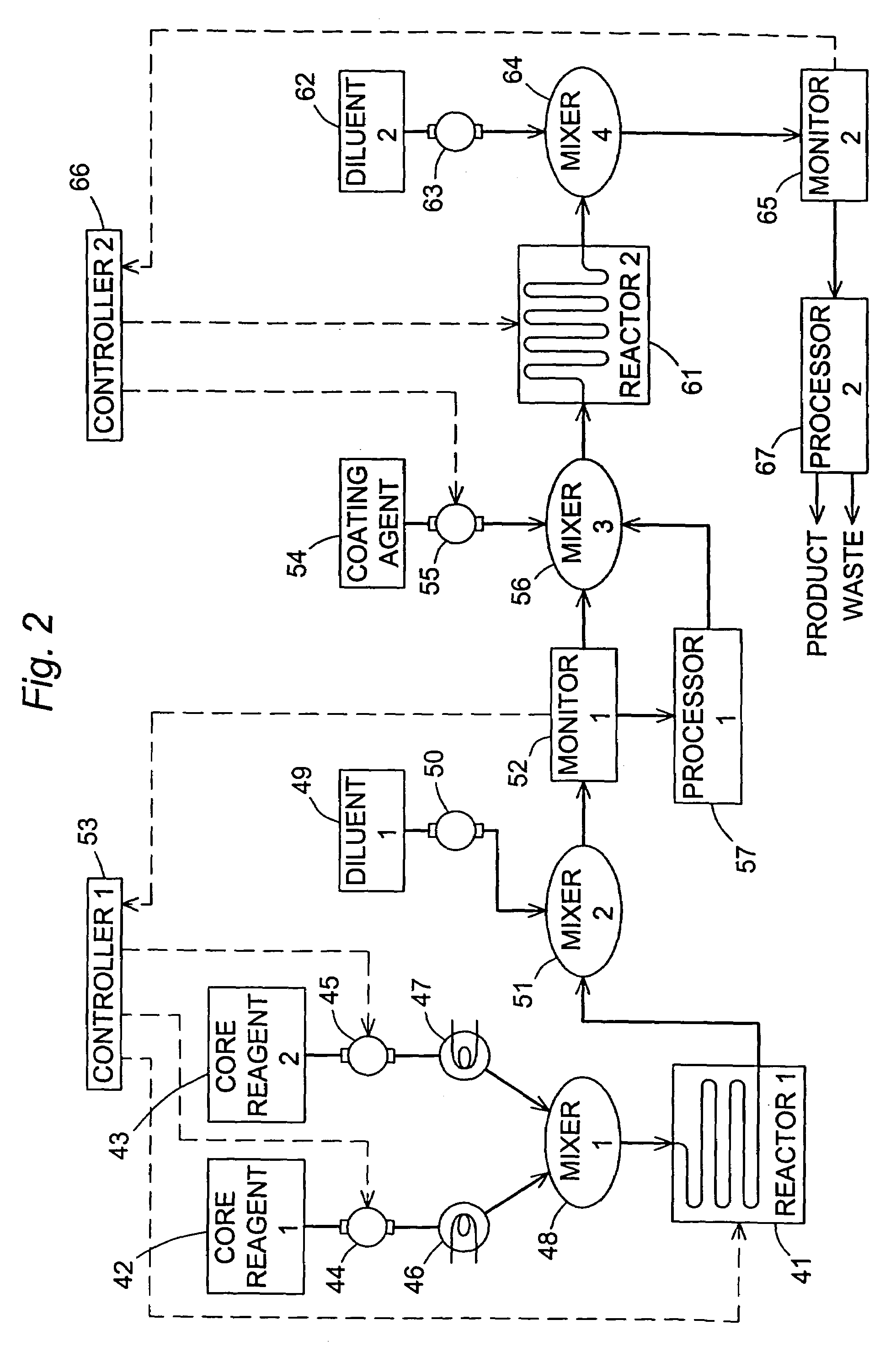Flow synthesis of quantum dot nanocrystals
a quantum dot nanocrystal and nanocrystal technology, applied in the direction of nanoinformatics, crystal growth process, polycrystalline material growth, etc., can solve the problems of poor reproducibility of products, lack of precise control, and inability to control precision
- Summary
- Abstract
- Description
- Claims
- Application Information
AI Technical Summary
Benefits of technology
Problems solved by technology
Method used
Image
Examples
example 1
[0046]This example demonstrates the use of the present invention in preparing nanocrystals of CdSe, and the ability of an on-line fluorescence monitoring cell to differentiate between products prepared at different reaction temperatures, flow rates and the like.
[0047]A solution was prepared by dissolving 0.179 g of selenium in 16 mL of tri-n-octylphosphine (TOP) and adding 0.115 mL of dimethyl cadmium. Separately, tri-n-octylphosphine oxide (TOPO) (12.5 g) was heated under vacuum to 180° C. and then maintained at 65° C. under dry nitrogen. The heated TOPO was then combined with 7 mL of the TOP solution of selenium and dimethyl cadmium. A continuous-flow reaction was then performed, using the apparatus depicted in FIG. 1, with a reaction tube consisting of 50 cm of 0.03-inch (0.76 mm) stainless steel tubing coiled tightly and cast into a zinc block. The flow rate of the reaction mixture through the tubing was 200 μL / minute, and the zinc block was variously maintained at temperatures ...
example 2
[0049]This example is a further illustration of the preparation of CdSe nanocrystals and the use of fluorescence monitoring by a process in accordance with the present invention, showing the ability of the invention to differentiate between products prepared at different reaction temperatures and flow rates. The reaction materials in this case were cadmium acetate hydrate (0.5 g) and tetradecylphosphonic acid (TDPA) (1.6 g) dissolved in 5.0 mL tri-n-octylphosphine (TOP). The resulting solution was heated at 230° C. with continuous sparging for approximately one hour. The reaction mixture was then cooled to near room temperature and combined with tri-n-octylphosphine oxide (TOPO) (10 g). This was followed by reheating of the reaction mixture under vacuum to 195° C. for an additional hour, then cooling to 60° C. A 1.0 M solution of selenium in TOP (2.7 mL) was then added via syringe. Aliquots of this final stock solution were withdrawn and passed through the same continuous flow syste...
example 3
[0052]This example is yet a further illustration of the preparation of CdSe nanocrystals and the use of fluorescence monitoring by a process in accordance with the present invention, showing the ability of the invention to differentiate between products prepared at different flow rates.
[0053]In this example, CYANEX® 272, which is a mixture of phosphorous-containing compounds of which 87% is bis (2,4,4-trimethylpentyl)phosphinic acid (CAS Reg. No. 83411-71-6, Cytec Industries Inc., West Patterson, N.J., USA), was included as an additive to effect redox and sequestration control of the nanocrystal-forming reactions. The reaction was carried out in the same apparatus as that described in the preceding examples, with the temperature of the flow apparatus maintained at a constant 310C while flow rates of 100 μL / min and 600 μL / min were used.
[0054]Anhydrous cadmium acetate was obtained from PROCHEM (Chandler, Arizona, USA). Aside from the CYANEX® 272, all other reagents were as described i...
PUM
| Property | Measurement | Unit |
|---|---|---|
| temperature | aaaaa | aaaaa |
| temperature | aaaaa | aaaaa |
| diameters | aaaaa | aaaaa |
Abstract
Description
Claims
Application Information
 Login to View More
Login to View More - R&D
- Intellectual Property
- Life Sciences
- Materials
- Tech Scout
- Unparalleled Data Quality
- Higher Quality Content
- 60% Fewer Hallucinations
Browse by: Latest US Patents, China's latest patents, Technical Efficacy Thesaurus, Application Domain, Technology Topic, Popular Technical Reports.
© 2025 PatSnap. All rights reserved.Legal|Privacy policy|Modern Slavery Act Transparency Statement|Sitemap|About US| Contact US: help@patsnap.com



